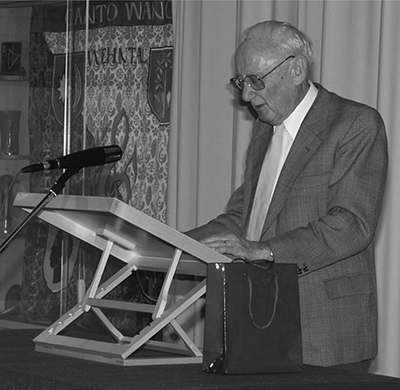Walter Hälg (1917–2011)
 Walter Hälg, the pioneer of reactor technology and neutron scattering in Switzerland, passed away peacefully on December 28, 2011 at the age of 94. He is well known to the worldwide neutron scattering community through his generous sponsorship of the Walter Hälg Prize which has been awarded biannually to distinguished scientists by the European Neutron Scattering Association (ENSA) since 1999.
Walter Hälg, the pioneer of reactor technology and neutron scattering in Switzerland, passed away peacefully on December 28, 2011 at the age of 94. He is well known to the worldwide neutron scattering community through his generous sponsorship of the Walter Hälg Prize which has been awarded biannually to distinguished scientists by the European Neutron Scattering Association (ENSA) since 1999.
Walter Hälg was born in Basel, where he spent his childhood. He was always fascinated by natural sciences, hence he studied physics, chemistry and mathematics at the local university, which was a center of spectroscopy, and he received his Ph.D. degree in molecular physics in 1943. At that time, most experimental equipment was not available commercially, forcing him to build the vacuum spectrograph necessary for his studies by himself. His Ph.D. work addressed interesting UV-spectroscopy investigations on indium and gallium halogenides, the predecessors of materials used in today's semiconductor technology. In 1943, he joined the particle physics group at the University of Basel, given the task to construct a 1 MeV Cockcroft-Walton accelerator.
Walter Hälg's innate pioneering spirit encouraged him to move into new fields. After 1946 he was involved in the design of nuclear reactors on behalf of the company Brown Boveri & Cie. Subsequently in 1952–53, he was delegated to the newly installed Norwegian research reactor JEEP at Kjeller. This was also the place where he first came into contact with neutron scattering. As a scientist trained in the field of spectroscopy, he immediately recognized the power of this new technique. Soon after the commissioning of the light water reactor SAPHIR (critical in 1957) and the heavy water reactor DIORIT (critical in 1960), both installed at Würenlingen (today's eastern site of the Paul Scherrer Institute), he started to build instruments for neutron scattering and made them available to a broad national and international user community. In this respect, Walter Hälg introduced the user system a long time before it was copied later by most of the neutron scattering centers around the world.
Due to his expertise, Walter Hälg was given the task to educate students in the field of reactor technology at the ETH Zurich. From 1955 to 1960 he was a lecturer, and in 1960 he was appointed as a full professor and director of the newly founded Institut für Reaktortechnik. His main fields of research were focusing on reactor theory, numerical mathematics, neutron scattering and computer science. In his institute, numerous students were educated and trained in neutron scattering, establishing a strong community in Switzerland. He steadily pushed the sustainable renewal and permanent upgrade of the instrumentation at the home neutron sources, and he initiated a large number of collaborations to tackle relevant scientific problems in novel fields. Whenever possible, he took active part in both the experiments and data analysis, resulting in a remarkable list of publications and citations. His work jointly performed with chemists of the University of Bern on the magnetic ordering and the location of hydrogen in the molecular complex prussian blue has still one of the highest number of citations (297) among all publications resulting from experiments ever performed on a Swiss neutron source up to the present [see Inorg. Chem. 19, 956 (1980)].
Many commissions and societies used Walter Hälg's expertise and wide interests nominating him as a member or chairman. He was a honorary member of both the distinguished Physical Society of Zurich and the Swiss Society for Neutron Scattering. He served for 10 years as a member and finally as president of the Research Commission of the ETH Zurich until his retirement in 1984. Albert Furrer continued Walter Hälg's work as the new head of the Laboratory for Neutron Scattering. In 1996, the neutron scattering activities were moved from the reactor SAPHIR to the newly built spallation neutron source SINQ, also based on ideas of Walter Hälg, who recognized the potential of the proton accelerator very early. However, the proton current of 0.1 mA was far too low to trigger such a neutron source at that time. Later, when the proton current was increased by an order of magnitude, Walter Fischer and his crew successfully realized this project, now being an established and internationally used large scale neutron facility.
We will always keep Walter Hälg in our memory, not only as a pioneer in reactor technology and neutron scattering, but also as a friend. We express our condolences to his wife Madeleine Hälg-Degen, who stayed by his side for more than 60 years. She will continue to sponsor the highly prestigious ENSA Prize which in the future will be called the Walter and Madeleine Hälg Prize.
Peter Fischer, Albert Furrer, and Jürg Schefer
PSI, Switzerland